SolNet: A Convolutional Neural Network for Detecting Dust on Solar Panels
Abstract
1. Introduction
- A new dataset of the dusty and clean solar panel is introduced that is free from class imbalance.
- The current stateoftheart (SOTA) algorithms are performed nearly 100% accurately on test sets of our dataset.
- SolNet, a CNN architecture that deals specifically with dust detection on solar panels is proposed and tested.
- The proposed model is evaluated and compared with SOTA to validate its efficiency.
- Both datasets and SolNet are proposed as benchmarks for future research endeavors.
2. Methodology
2.1. Dataset Description
2.2. AlexNet
2.3. Resnet50
2.4. InceptionV3
2.5. VGG16
2.6. Proposed CNN for Dust Detection: SolNet
3. Experimental Setup and Training
| Algorithm 1 |
4. Result Analysis
5. Discussion
6. Conclusions
Author Contributions
Funding
Data Availability Statement
Acknowledgments
Conflicts of Interest
Abbreviations
| ANN | Artificial Neural Network |
| AE-LSTM | Auto-Encoder Long Short-Term Memory |
| CNN | Convolutional Neural Network |
| DBSI | Dry Bare Soil Index |
| FC | Fully Connected |
| GHG | Green House Gas |
| GEE | Google Earth Engine |
| HSV | Hue Saturation Value |
| IoT | Internet of Things |
| KNN | K Nearest Neighbor |
| PV | Photo Voltaic |
| SOTA | State Of The Art |
| VGG | Visual Geometry Group |
References
- Kabir, A.; Sunny, M.R.; Siddique, N.I. Assessment of grid-connected residential PV-battery systems in Sweden-A Techno-economic Perspective. In Proceedings of the 2021 IEEE International Conference in Power Engineering Application (ICPEA), Shah Alam, Malaysia, 8–9 March 2021; pp. 73–78. [Google Scholar]
- IRENA. Renewable Capacity Statistics. 2022. Available online: https://www.irena.org/Publications/2022/Apr/Renewable-Capacity-Statistics-2022 (accessed on 23 August 2022).
- Ritchie, H.; Roser, M.; Rosado, P. Renewable energy. Our World in Data. 2020. Available online: https://ourworldindata.org/renewable-energy (accessed on 24 August 2022).
- Chanchangi, Y.N.; Ghosh, A.; Sundaram, S.; Mallick, T.K. Dust and PV Performance in Nigeria: A review. Renew. Sustain. Energy Rev. 2020, 121, 109704. [Google Scholar] [CrossRef]
- Tanesab, J.; Parlevliet, D.; Whale, J.; Urmee, T. Dust effect and its economic analysis on PV modules deployed in a temperate climate zone. Energy Procedia 2016, 100, 65–68. [Google Scholar] [CrossRef]
- Maghami, M.R.; Hizam, H.; Gomes, C.; Radzi, M.A.; Rezadad, M.I.; Hajighorbani, S. Power loss due to soiling on solar panel: A review. Renew. Sustain. Energy Rev. 2016, 59, 1307–1316. [Google Scholar] [CrossRef]
- Santhakumari, M.; Sagar, N. A review of the environmental factors degrading the performance of silicon wafer-based photovoltaic modules: Failure detection methods and essential mitigation techniques. Renew. Sustain. Energy Rev. 2019, 110, 83–100. [Google Scholar] [CrossRef]
- Kabir, M.A.; Islam, R.; Nazifa, S.; Choudhury, R. Dust Effect on Photovoltaic Output Performance: Comparative Analysis and A Case Study in Dhaka, Bangladesh. In Proceedings of the 2021 International Conference on Automation, Control and Mechatronics for Industry 4.0 (ACMI), Rajshahi, Bangladesh, 8–9 July 2021; pp. 1–6. [Google Scholar]
- Dantas, G.M.; Mendes, O.L.C.; Maia, S.M.; de Alexandria, A.R. Detecção de poeira em painel solar usando técnicas de processamento de imagem: Uma revisão Dust detection in solar panel using image processing techniques: A review Detección de polvo en el panel solar utilizando técnicas de procesamiento por imágenes: Una revisión. Res. Soc. Dev. 2020, 9, e321985107. [Google Scholar]
- Ghosh, A. Soiling losses: A barrier for India’s energy security dependency from photovoltaic power. Challenges 2020, 11, 9. [Google Scholar] [CrossRef]
- Ullah, A.; Imran, H.; Maqsood, Z.; Butt, N.Z. Investigation of optimal tilt angles and effects of soiling on PV energy production in Pakistan. Renew. Energy 2019, 139, 830–843. [Google Scholar] [CrossRef]
- Paudyal, B.R.; Shakya, S.R. Dust accumulation effects on efficiency of solar PV modules for off grid purpose: A case study of Kathmandu. Sol. Energy 2016, 135, 103–110. [Google Scholar] [CrossRef]
- Costa, S.C.; Diniz, A.S.A.; Kazmerski, L.L. Solar energy dust and soiling R&D progress: Literature review update for 2016. Renew. Sustain. Energy Rev. 2018, 82, 2504–2536. [Google Scholar]
- Kazem, H.A.; Chaichan, M.T.; Al-Waeli, A.H.; Sopian, K. A review of dust accumulation and cleaning methods for solar photovoltaic systems. J. Clean. Prod. 2020, 276, 123187. [Google Scholar] [CrossRef]
- Ramli, M.A.; Prasetyono, E.; Wicaksana, R.W.; Windarko, N.A.; Sedraoui, K.; Al-Turki, Y.A. On the investigation of photovoltaic output power reduction due to dust accumulation and weather conditions. Renew. Energy 2016, 99, 836–844. [Google Scholar] [CrossRef]
- Benghanem, M.; Almohammedi, A.; Khan, M.T.; Al-Masraqi, A. Effect of dust accumulation on the performance of photovoltaic panels in desert countries: A case study for Madinah, Saudi Arabia. Int. J. Power Electron. Drive Syst. 2018, 9, 1356. [Google Scholar] [CrossRef]
- Gholami, A.; Khazaee, I.; Eslami, S.; Zandi, M.; Akrami, E. Experimental investigation of dust deposition effects on photo-voltaic output performance. Sol. Energy 2018, 159, 346–352. [Google Scholar] [CrossRef]
- Kazem, H.A.; Chaichan, M.T. Experimental analysis of the effect of dust’s physical properties on photovoltaic modules in Northern Oman. Sol. Energy 2016, 139, 68–80. [Google Scholar] [CrossRef]
- Chaudhary, A.; Chaturvedi, D. Thermal Image Analysis and Segmentation to Study Temperature Effects of Cement and Bird Deposition on Surface of Solar Panels. Int. J. Image, Graph. Signal Process. 2017, 9, 12–22. [Google Scholar] [CrossRef]
- Phoolwani, U.K.; Sharma, T.; Singh, A.; Gawre, S.K. IoT Based Solar Panel Analysis using Thermal Imaging. In Proceedings of the 2020 IEEE International Students’ Conference on Electrical, Electronics and Computer Science (SCEECS), Bhopal, India, 22–23 February 2020; pp. 1–5. [Google Scholar] [CrossRef]
- Cubukcu, M.; Akanalci, A. Real-time inspection and determination methods of faults on photovoltaic power systems by thermal imaging in Turkey. Renew. Energy 2020, 147, 1231–1238. [Google Scholar] [CrossRef]
- Thomas, S.K.; Joseph, S.; Sarrop, T.; Haris, S.B.; Roopak, R. Solar Panel Automated Cleaning (SPAC) System. In Proceedings of the 2018 International Conference on Emerging Trends and Innovations In Engineering And Technological Research (ICETIETR), Ernakulam, India, 11–13 July 2018; pp. 1–3. [Google Scholar] [CrossRef]
- Zainuddin, N.F.; Mohammed, M.N.; Al-Zubaidi, S.; Khogali, S.I. Design and Development of Smart Self-Cleaning Solar Panel System. In Proceedings of the 2019 IEEE International Conference on Automatic Control and Intelligent Systems (I2CACIS), Selangor, Malaysia, 29 June 2019; pp. 40–43. [Google Scholar] [CrossRef]
- Mohammed, H.A.; Al-Hilli, B.A.M.; Al-Mejibli, I.S. Smart system for dust detecting and removing from solar cells. J. Phys. Conf. Ser. 2018, 1032, 012055. [Google Scholar] [CrossRef]
- Santosh Kumar, S.; Shankar, S.; Murthy, K. Solar Powered PV Panel Cleaning Robot. In Proceedings of the 2020 International Conference on Recent Trends on Electronics, Information, Communication & Technology (RTEICT), Bangalore, India, 12–13 November 2020; pp. 169–172. [Google Scholar] [CrossRef]
- Minh, H.V.T.; Avtar, R.; Mohan, G.; Misra, P.; Kurasaki, M. Monitoring and mapping of rice cropping pattern in flooding area in the Vietnamese Mekong delta using Sentinel-1A data: A case of an Giang province. ISPRS Int. J. Geo Inf. 2019, 8, 211. [Google Scholar] [CrossRef]
- Supe, H.; Avtar, R.; Singh, D.; Gupta, A.; Yunus, A.P.; Dou, J.; A Ravankar, A.; Mohan, G.; Chapagain, S.K.; Sharma, V.; et al. Google earth engine for the detection of soiling on photovoltaic solar panels in arid environments. Remote Sens. 2020, 12, 1466. [Google Scholar] [CrossRef]
- Abuqaaud, K.A.; Ferrah, A. A novel technique for detecting and monitoring dust and soil on solar photovoltaic panel. In Proceedings of the 2020 Advances in Science and Engineering Technology International Conferences (ASET), Dubai, United Arab Emirates, 4 February–9 April 2020; pp. 1–6. [Google Scholar]
- Tribak, H.; Zaz, Y. Dust Soiling Concentration Measurement on Solar Panels based on Image Entropy. In Proceedings of the 2019 7th International Renewable and Sustainable Energy Conference (IRSEC), Agadir, Morocco, 27–30 November 2019; pp. 1–4. [Google Scholar]
- Sunny, M.R.; Kabir, M.A.; Naheen, I.T.; Ahad, M.T. Residential energy management: A machine learning perspective. In Proceedings of the 2020 IEEE Green Technologies Conference (GreenTech), Oklahoma City, OK, USA, 1–3 April 2020; pp. 229–234. [Google Scholar]
- Igathinathane, C.; Melin, S.; Sokhansanj, S.; Bi, X.; Lim, C.; Pordesimo, L.; Columbus, E. Machine vision based particle size and size distribution determination of airborne dust particles of wood and bark pellets. Powder Technol. 2009, 196, 202–212. [Google Scholar] [CrossRef]
- Maitre, J.; Bouchard, K.; Bédard, L.P. Mineral grains recognition using computer vision and machine learning. Comput. Geosci. 2019, 130, 84–93. [Google Scholar] [CrossRef]
- Proietti, A.; Panella, M.; Leccese, F.; Svezia, E. Dust detection and analysis in museum environment based on pattern recognition. Measurement 2015, 66, 62–72. [Google Scholar] [CrossRef]
- Saquib, D.; Nasser, M.N.; Ramaswamy, S. Image Processing Based Dust Detection and prediction of Power using ANN in PV systems. In Proceedings of the 2020 Third International Conference on Smart Systems and Inventive Technology (ICSSIT), Tirunelveli, India, 20–22 August 2020; pp. 1286–1292. [Google Scholar] [CrossRef]
- Mehta, S.; Azad, A.P.; Chemmengath, S.A.; Raykar, V.; Kalyanaraman, S. Deepsolareye: Power loss prediction and weakly supervised soiling localization via fully convolutional networks for solar panels. In Proceedings of the 2018 IEEE Winter Conference on Applications of Computer Vision (WACV), Lake Tahoe, NV, USA, 12–15 March 2018; pp. 333–342. [Google Scholar]
- Fan, S.; Wang, Y.; Cao, S.; Zhao, B.; Sun, T.; Liu, P. A deep residual neural network identification method for uneven dust accumulation on photovoltaic (PV) panels. Energy 2022, 239, 122302. [Google Scholar] [CrossRef]
- Maity, R.; Shamaun Alam, M.; Pati, A. An Approach for Detection of Dust on Solar Panels Using CNN from RGB Dust Image to Predict Power Loss. In Cognitive Computing in Human Cognition; Springer: Berlin/Heidelberg, Germany, 2020; pp. 41–48. [Google Scholar]
- Zyout, I.; Oatawneh, A. Detection of PV Solar Panel Surface Defects using Transfer Learning of the Deep Convolutional Neural Networks. In Proceedings of the 2020 Advances in Science and Engineering Technology International Conferences (ASET), Dubai, United Arab Emirates, 4 February–9 April 2020; pp. 1–4. [Google Scholar] [CrossRef]
- Alimi, O.A.; Meyer, E.L.; Olayiwola, O.I. Solar Photovoltaic Modules’ Performance Reliability and Degradation Analysis—A Review. Energies 2022, 15, 5964. [Google Scholar] [CrossRef]
- Khilar, R.; Suba, G.M.; Kumar, T.S.; Samson Isaac, J.; Shinde, S.K.; Ramya, S.; Prabhu, V.; Erko, K.G. Improving the Efficiency of Photovoltaic Panels Using Machine Learning Approach. Int. J. Photoenergy 2022, 1–6. [Google Scholar] [CrossRef]
- Almalki, F.A.; Albraikan, A.A.; Soufiene, B.O.; Ali, O. Utilizing Artificial Intelligence and Lotus Effect in an Emerging Intelligent Drone for Persevering Solar Panel Efficiency. Wirel. Commun. Mob. Comput. 2022, 1–12. [Google Scholar] [CrossRef]
- Ibrahim, M.; Alsheikh, A.; Awaysheh, F.M.; Alshehri, M.D. Machine learning schemes for anomaly detection in solar power plants. Energies 2022, 15, 1082. [Google Scholar] [CrossRef]
- Yousif, J.H.; Kazem, H.A.; Al-Balushi, H.; Abuhmaidan, K.; Al-Badi, R. Artificial Neural Network Modelling and Experimental Evaluation of Dust and Thermal Energy Impact on Monocrystalline and Polycrystalline Photovoltaic Modules. Energies 2022, 15, 4138. [Google Scholar] [CrossRef]
- Simonyan, K.; Zisserman, A. Very Deep Convolutional Networks for Large-Scale Image Recognition. arXiv 2014, arXiv:1409.1556. [Google Scholar]
- Szegedy, C.; Vanhoucke, V.; Ioffe, S.; Shlens, J.; Wojna, Z. Rethinking the Inception Architecture for Computer Vision. In Proceedings of the 2016 IEEE Conference on Computer Vision and Pattern Recognition (CVPR), Las Vegas, NV, USA, 27–30 June 2016; pp. 2818–2826. [Google Scholar]
- He, K.; Zhang, X.; Ren, S.; Sun, J. Deep Residual Learning for Image Recognition. In Proceedings of the 2016 IEEE Conference on Computer Vision and Pattern Recognition (CVPR), Las Vegas, NV, USA, 27–30 June 2016; pp. 770–778. [Google Scholar]
- Krizhevsky, A.; Sutskever, I.; Hinton, G.E. ImageNet Classification with Deep Convolutional Neural Networks. In Advances in Neural Information Processing Systems; Pereira, F., Burges, C., Bottou, L., Weinberger, K., Eds.; Curran Associates, Inc.: New York, NY, USA, 2012; Volume 25. [Google Scholar]
- Russakovsky, O.; Deng, J.; Su, H.; Krause, J.; Satheesh, S.; Ma, S.; Huang, Z.; Karpathy, A.; Khosla, A.; Bernstein, M.; et al. ImageNet Large Scale Visual Recognition Challenge. Int. J. Comput. Vis. 2015, 115, 211–252. [Google Scholar] [CrossRef]
- Onim, M.S.H.; Nyeem, H.; Roy, K.; Hasan, M.; Ishmam, A.; Akif, M.A.H.; Ovi, T.B. BLPnet: A new DNN model and Bengali OCR engine for Automatic Licence Plate Recognition. Array 2022, 15, 100244. [Google Scholar] [CrossRef]
- Stehman, S.V. Selecting and interpreting measures of thematic classification accuracy. Remote Sens. Environ. 1997, 62, 77–89. [Google Scholar] [CrossRef]
- Bergmeir, C.; Hyndman, R.J.; Koo, B. A note on the validity of cross-validation for evaluating autoregressive time series prediction. Comput. Stat. Data Anal. 2018, 120, 70–83. [Google Scholar] [CrossRef]
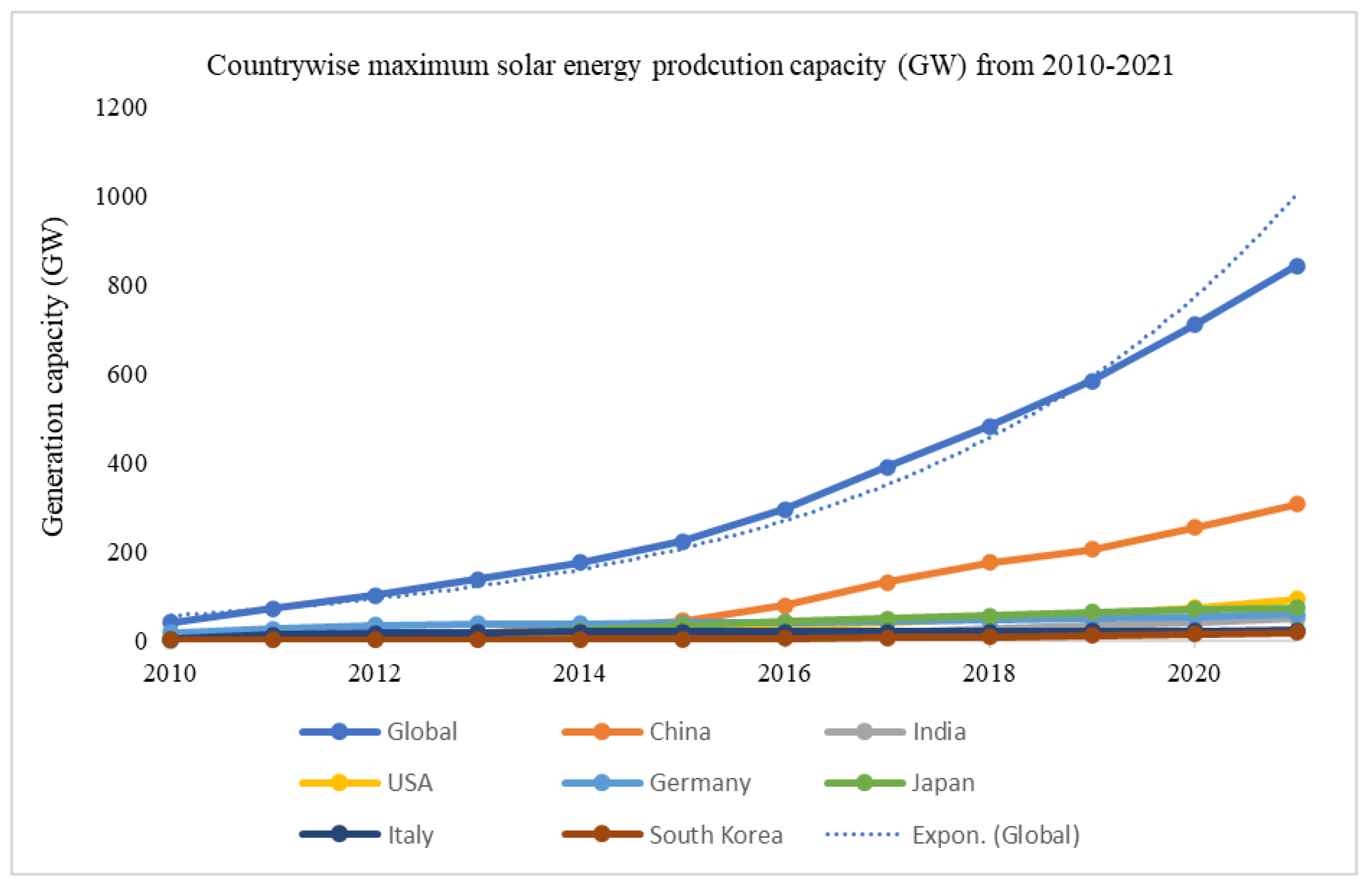
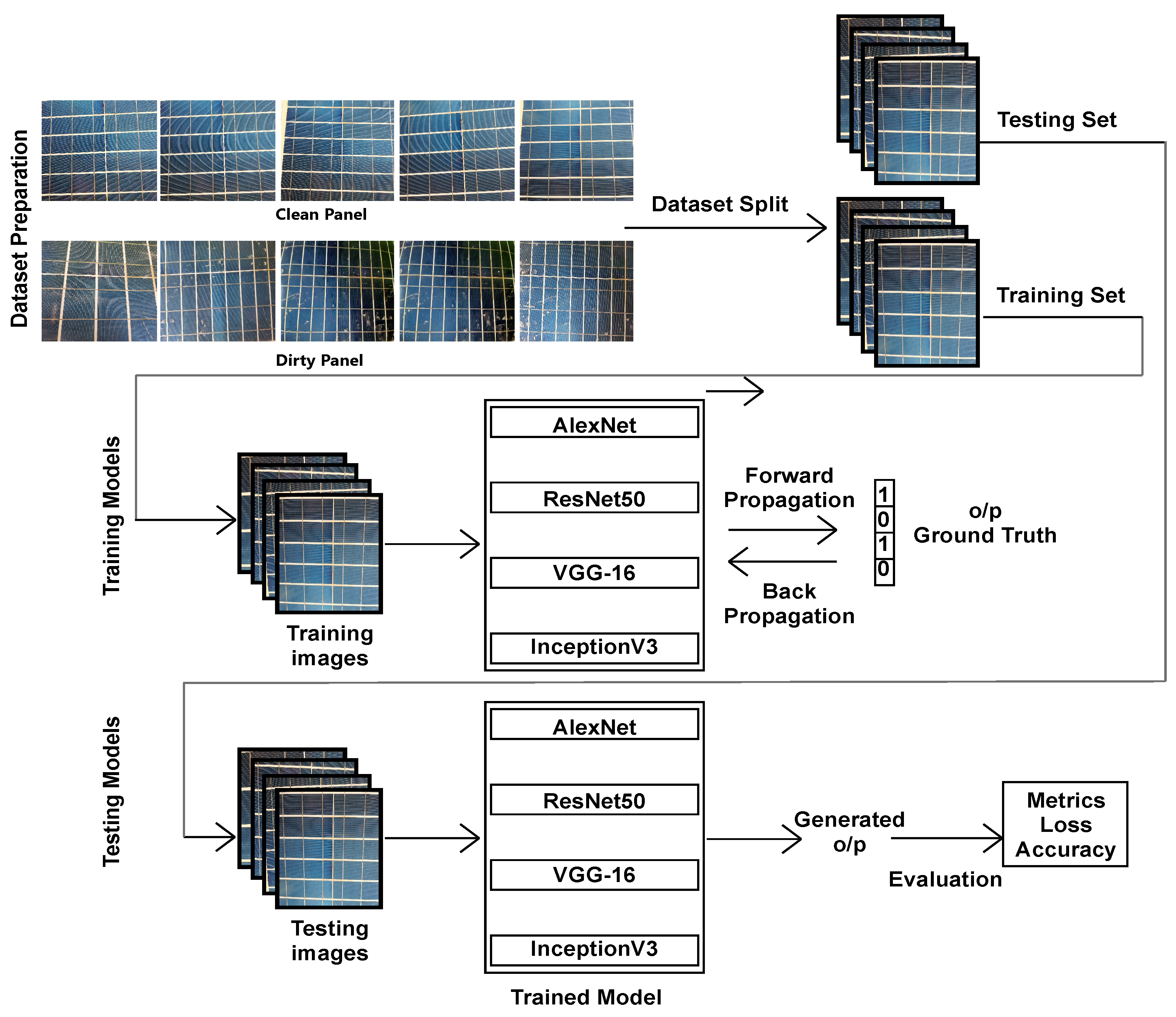
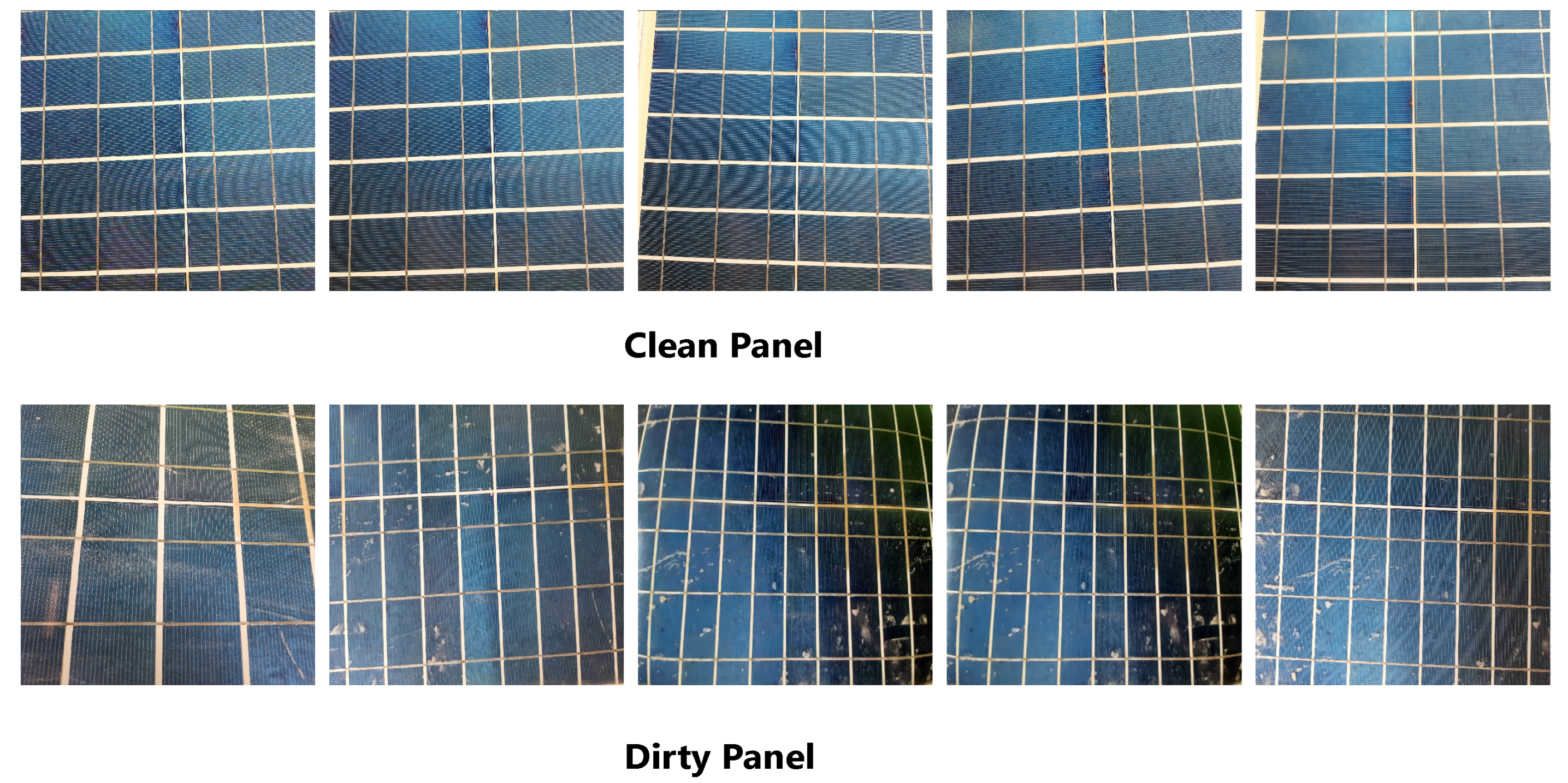
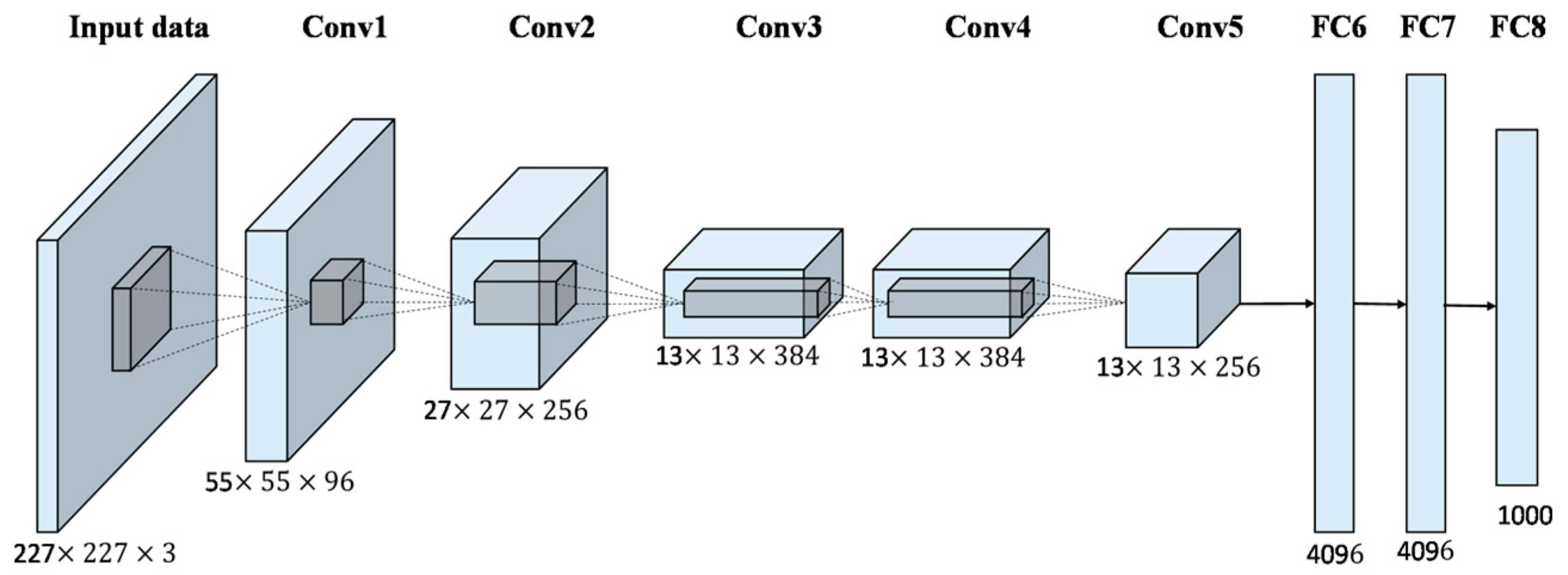
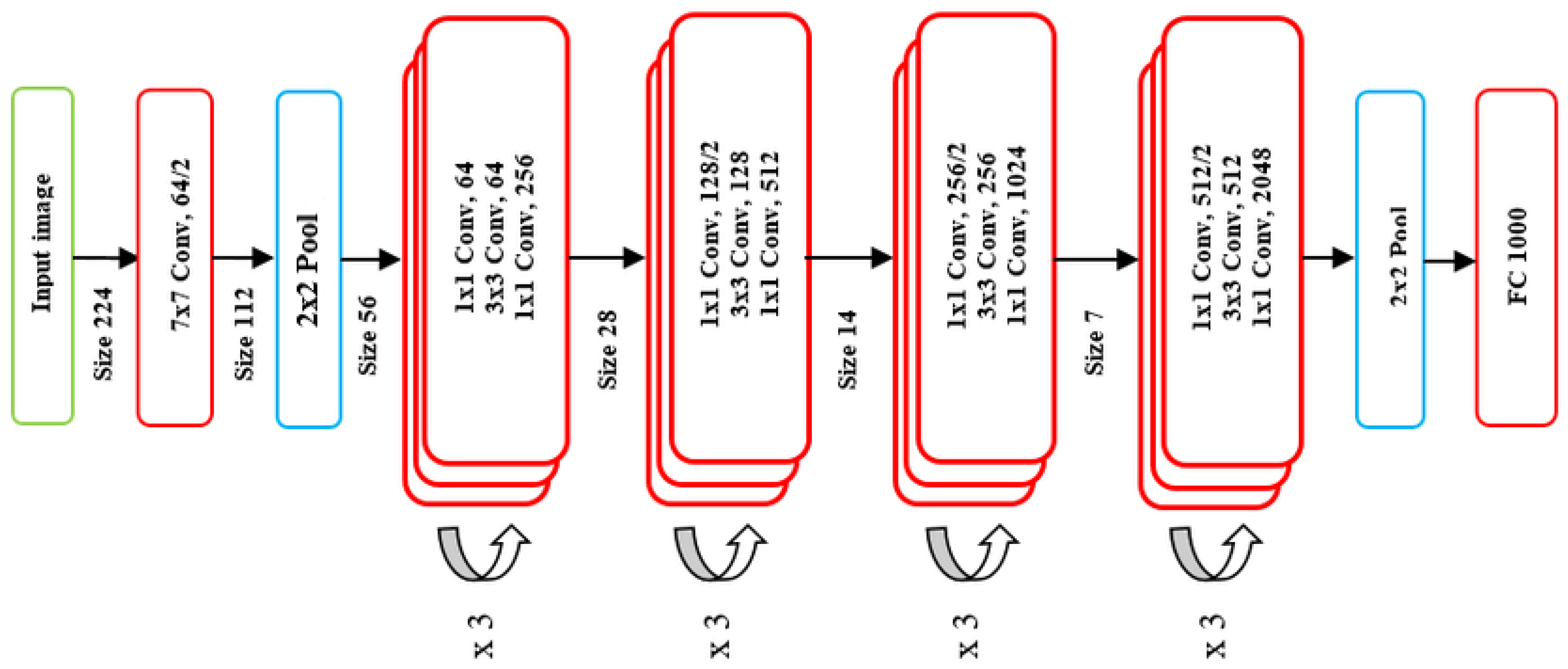


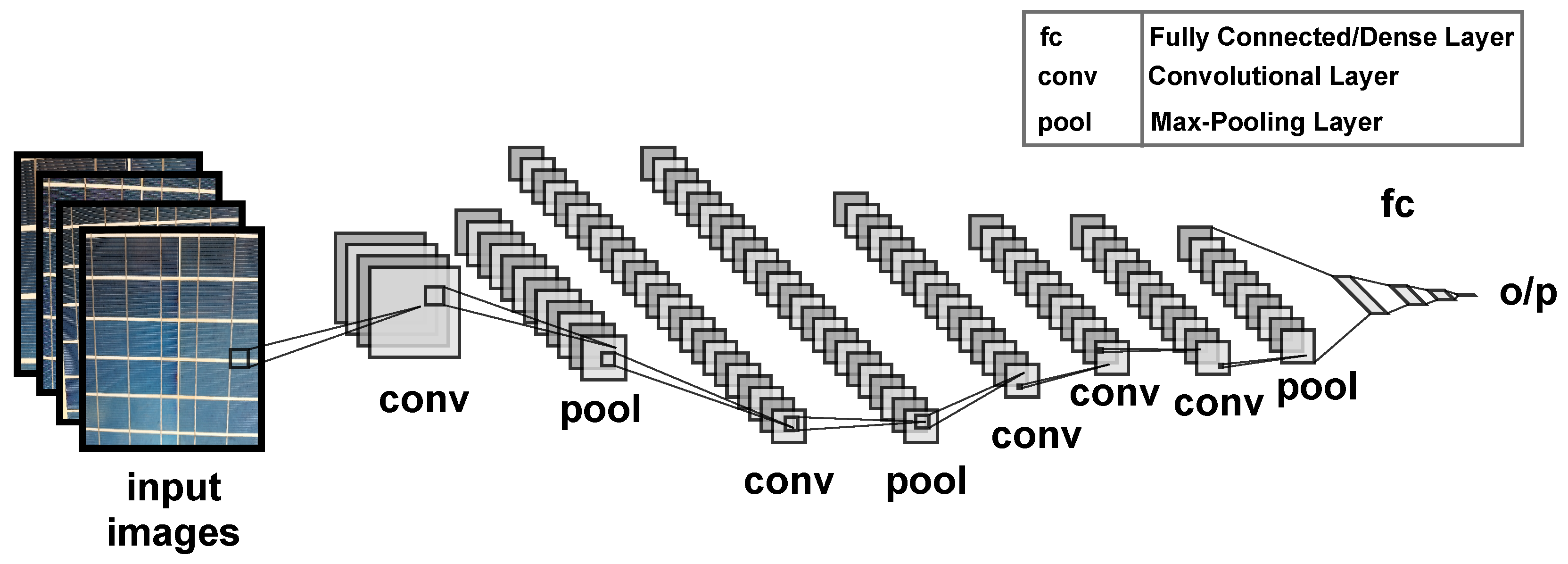
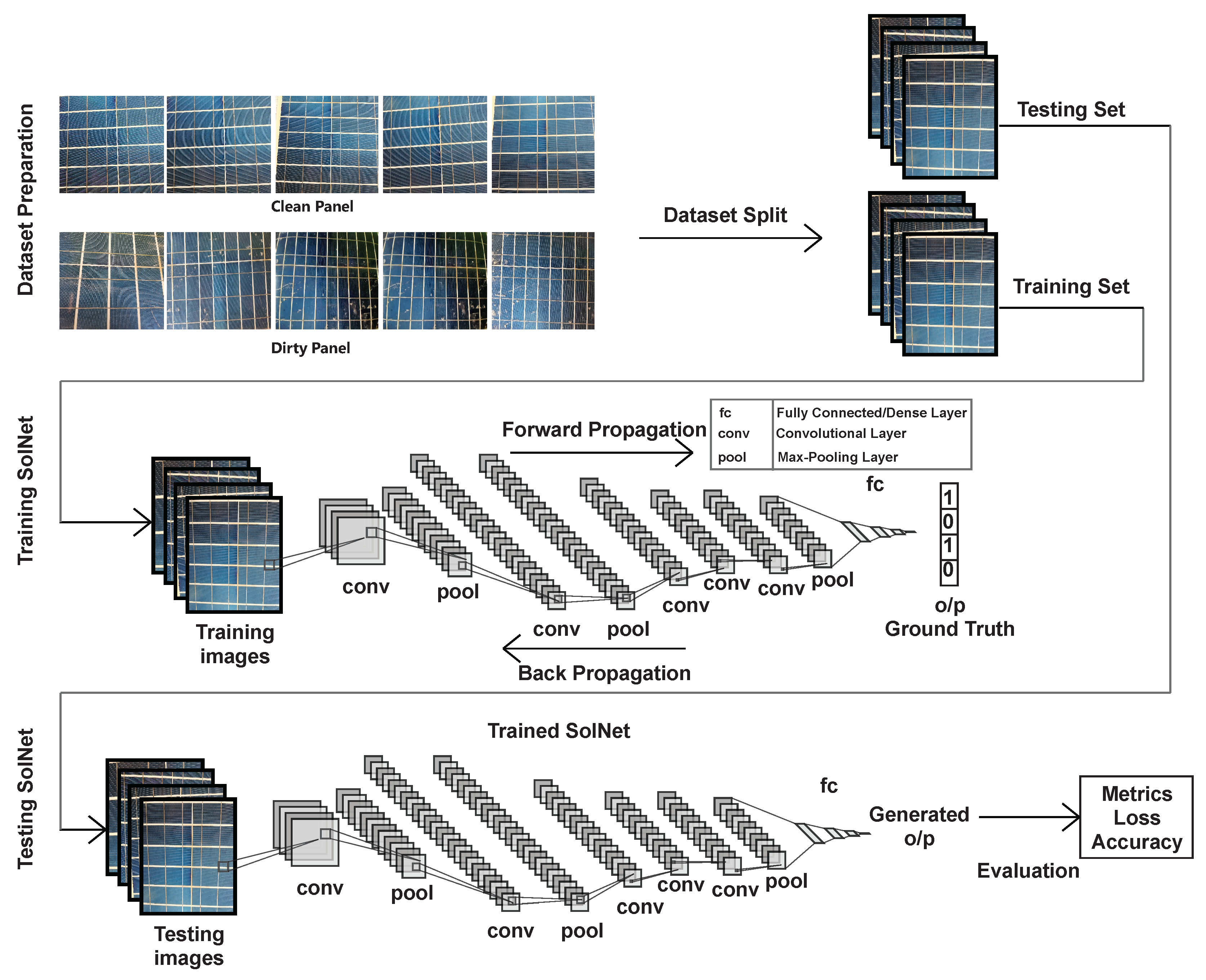
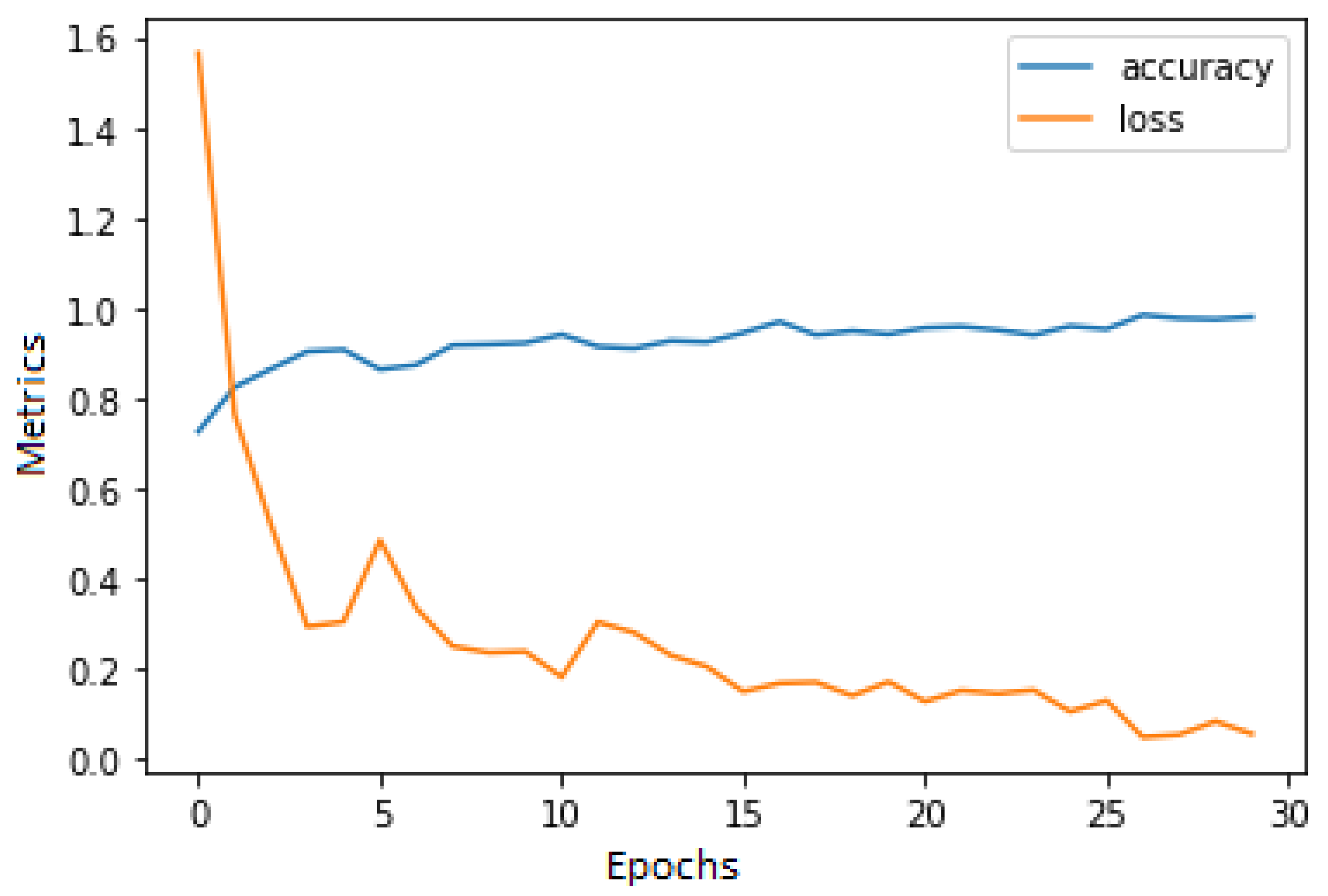
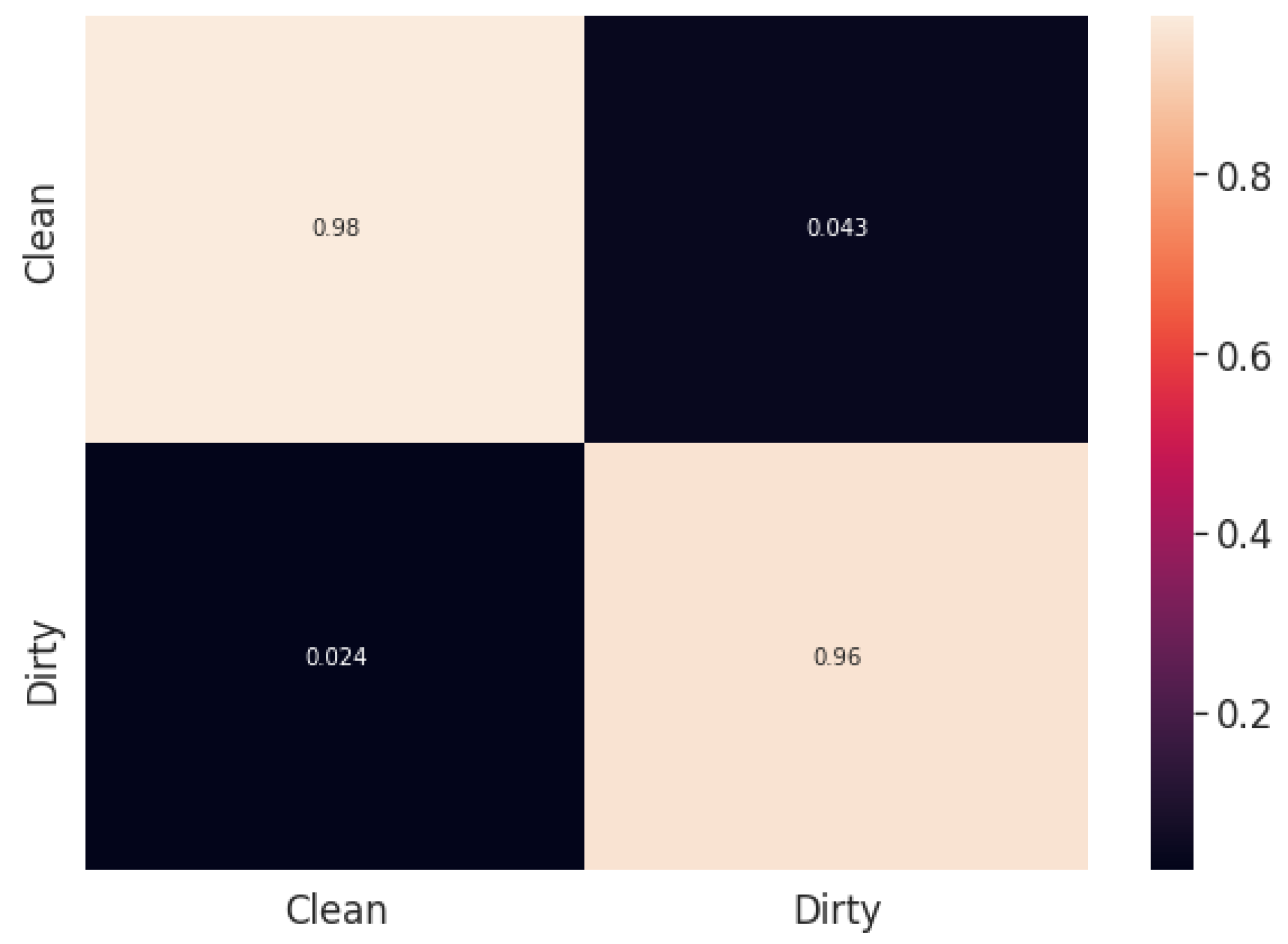
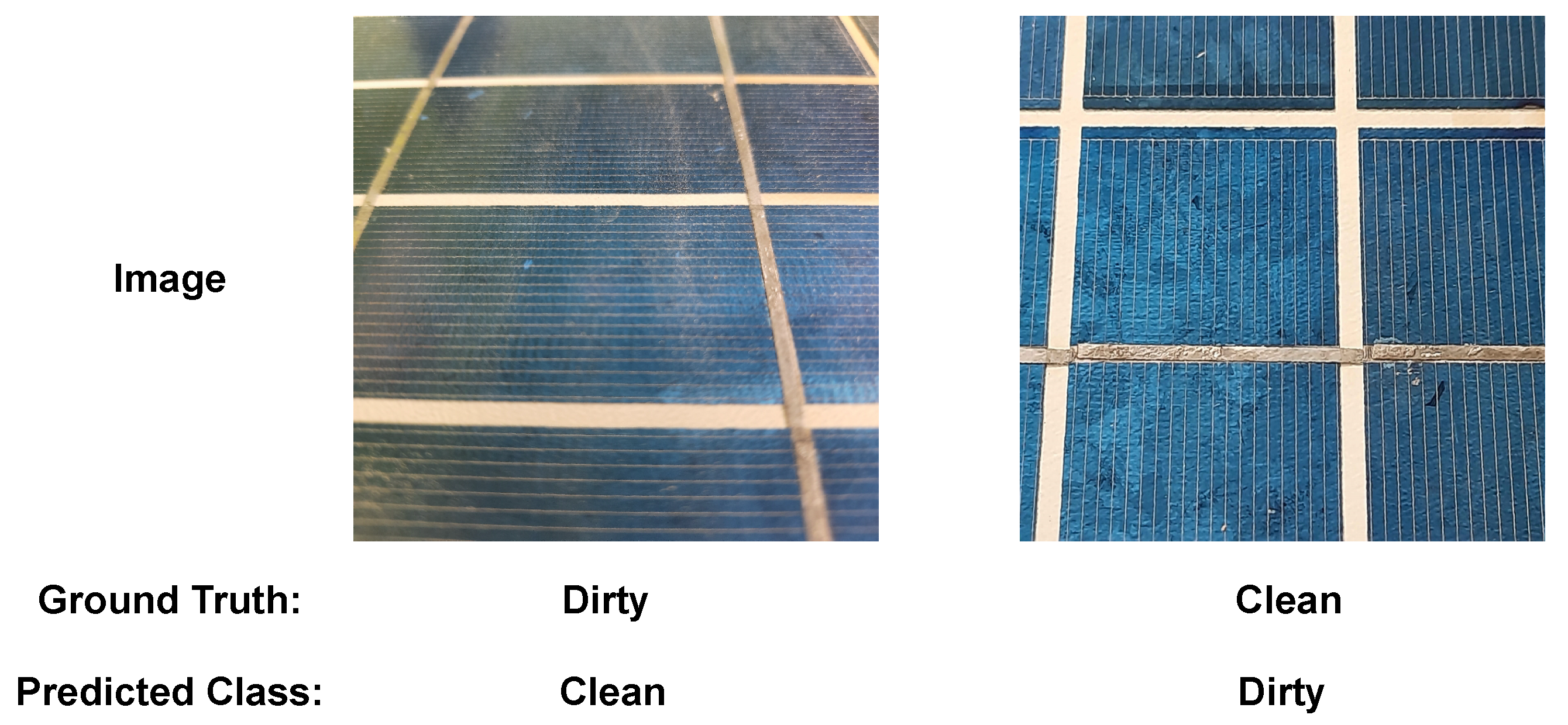
| Image Split | Clean Panel | Dirty Panel |
|---|---|---|
| Training Images | 708 | 683 |
| Testing Images | 422 | 418 |
| Total Images | 1130 | 1101 |
| Layer Name | Input Shape |
|---|---|
| Conv1 | |
| Pooling | |
| Conv2 | |
| Pooling | |
| Conv3 | |
| Conv4 | |
| Conv5 | |
| Pooling | |
| Fully Connected 1 | 4096 |
| Dropout | 4096 |
| Fully Connected 2 | 4096 |
| Fully Connected 3 | 1000 |
| Layer Name | Input Shape |
|---|---|
| Conv 1 | |
| Pooling | |
| Conv Block 1 | |
| Conv Block 2 | |
| Conv Block 3 | |
| Pooling | |
| Fully Connected | 1000 |
| Layer Name | Input Shape |
|---|---|
| Conv | |
| Conv | |
| Conv Padded | |
| Pooling | |
| Conv | |
| Conv | |
| Inception | |
| Inception | |
| Inception | |
| Pooling | |
| Linear | |
| Dense |
| Layer Name | Input Shape |
|---|---|
| Conv 1-1 | |
| Conv 1-2 | |
| Pooling | |
| Conv 2-1 | |
| Conv 2-2 | |
| Pooling | |
| Conv 3-1 | |
| Conv 3-2 | |
| Conv 3-3 | |
| Pooling | |
| Conv4-1 | |
| Conv4-2 | |
| Conv4-3 | |
| Pooling | |
| Conv5-1 | |
| Conv5-2 | |
| Conv5-3 | |
| Pooling | |
| Flatten | 25088 |
| Dense | 4096 |
| Dense | 4096 |
| Dense | 1000 |
| Parameter | Value |
|---|---|
| Backbone | Custom |
| Classes | 2(Binary) |
| Batch size | 32 |
| Image size | |
| Optimiser | Adam |
| Learning rate (Lr) | 0.0001 |
| Loss | Binary Cross-entropy |
| Output layer activation | sigmoid |
| Epochs | 30 |
| Processor | Xeon (2.3 GHz) |
| RAM | 12 GB |
| GPU | Tesla K80 (12 GB) |
| Fold Sequence | Avg Accuracy | Loss |
|---|---|---|
| Fold-1 | 99.62% (highest) | 0.89 |
| Fold-2 | 96.46 (lowest)% | 1.29 |
| Fold-3 | 98.52% | 1.75 |
| Fold-4 | 97.79% | 0.93 |
| Fold-5 | 98.61% | 0.74 |
| Average | 98.2% | 1.12 |
| Ground-Truth Class | |||
|---|---|---|---|
| Clean | Dirty | ||
| Predicted class | Clean Dirty | 412 10 | 18 400 |
| Precision | |||
Disclaimer/Publisher’s Note: The statements, opinions and data contained in all publications are solely those of the individual author(s) and contributor(s) and not of MDPI and/or the editor(s). MDPI and/or the editor(s) disclaim responsibility for any injury to people or property resulting from any ideas, methods, instructions or products referred to in the content. |
© 2022 by the authors. Licensee MDPI, Basel, Switzerland. This article is an open access article distributed under the terms and conditions of the Creative Commons Attribution (CC BY) license (https://creativecommons.org/licenses/by/4.0/).
Share and Cite
Onim, M.S.H.; Sakif, Z.M.M.; Ahnaf, A.; Kabir, A.; Azad, A.K.; Oo, A.M.T.; Afreen, R.; Hridy, S.T.; Hossain, M.; Jabid, T.; et al. SolNet: A Convolutional Neural Network for Detecting Dust on Solar Panels. Energies 2023, 16, 155. https://doi.org/10.3390/en16010155
Onim MSH, Sakif ZMM, Ahnaf A, Kabir A, Azad AK, Oo AMT, Afreen R, Hridy ST, Hossain M, Jabid T, et al. SolNet: A Convolutional Neural Network for Detecting Dust on Solar Panels. Energies. 2023; 16(1):155. https://doi.org/10.3390/en16010155
Chicago/Turabian StyleOnim, Md Saif Hassan, Zubayar Mahatab Md Sakif, Adil Ahnaf, Ahsan Kabir, Abul Kalam Azad, Amanullah Maung Than Oo, Rafina Afreen, Sumaita Tanjim Hridy, Mahtab Hossain, Taskeed Jabid, and et al. 2023. "SolNet: A Convolutional Neural Network for Detecting Dust on Solar Panels" Energies 16, no. 1: 155. https://doi.org/10.3390/en16010155
APA StyleOnim, M. S. H., Sakif, Z. M. M., Ahnaf, A., Kabir, A., Azad, A. K., Oo, A. M. T., Afreen, R., Hridy, S. T., Hossain, M., Jabid, T., & Ali, M. S. (2023). SolNet: A Convolutional Neural Network for Detecting Dust on Solar Panels. Energies, 16(1), 155. https://doi.org/10.3390/en16010155









